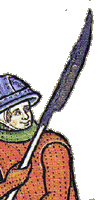Fauchard (3.5e Equipment)

|
|---|
| Fauchard from the Maciejowski Bible (at The Sword and the Rose) |
| |||||||||||
| Size | Cost1 | Damage | Weight1 | hp | |||||||
|---|---|---|---|---|---|---|---|---|---|---|---|
| Fine | * | 1d2 | * | 1 | |||||||
| Diminutive | * | 1d3 | * | 1 | |||||||
| Tiny | * | 1d4 | * | 2 | |||||||
| Small | 7 gp | 1d6 | 5 lb. | 5 | |||||||
| Medium | 7 gp | 1d8 | 10 lb. | 10 | |||||||
| Large | 14 gp | 2d6 | 20 lb. | 20 | |||||||
| Huge | * | 3d6 | * | 40 | |||||||
| Gargantuan | * | 4d6 | * | 80 | |||||||
| Colossal | * | 6d6 | * | 160 | |||||||
| |||||||||||
A fauchard has reach: you can strike opponents 10 feet away with it, but you can't use it against an adjacent foe.
A fauchard is a simple polearm with a curved, slashing blade atop a 6'-7' pole. The blade bore a moderate to strong curve along its length, however unlike a glaive the cutting edge was only on the concave side. This made the fauchard blade resemble that of a sickle or a scythe.
Historically, the fauchard was used in medieval Europe from the 11th through the 14th centuries. It was not a very efficient design for the purposes of war, and was eventually modified to have one or more lance points attached to the back or top of the blade. This weapon is called a fauchard-fork.
Back to Main Page → 3.5e Homebrew → Equipment → Mundane Weapons